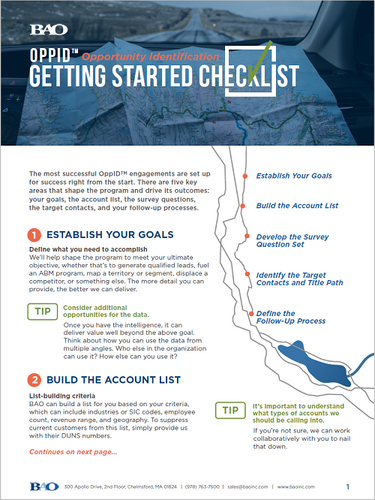Tip Sheets and Checklists
OppID Getting Started Checklist
Below are 5 key areas that shape your appointment setting program and drive its outcomes.

The most successful Opportunity Identification (OppID) engagements are set up for success right from the start.
Below are five key areas that shape the program and drive its outcomes: your goals, the account list, the survey questions, the target contacts, and your follow-up processes.
1. Establish Your Goals
Define what you need to accomplish:
We’ll help shape the program to meet your ultimate objective, whether that’s to generate qualified leads, fuel an ABM program, map a territory or segment, displace a competitor, or something else. The more detail you can provide, the better we can deliver.
TIP - Consider additional opportunities for the data:
Once you have the intelligence, it can deliver value well beyond the above goal. Think about how you can use the data from multiple angles. Who else in the organization can use it? How else can you use it?
2. Build the Account List
List-building criteria:
BAO can build a list for you based on your criteria, which can include industries or SIC codes, employee count, revenue range, and geography. To suppress current customers from this list, simply provide us with their DUNS numbers.
Required information:
If you plan to provide BAO with the list of accounts, it must include the company name, city and state, and phone number. If you are unable to provide city/state/phone, a DUNS number will suffice.
Target list size:
The total number of targeted accounts should be at least 7x the OppID commitment for the engagement. For example, a project with a 100 OppID commitment should have a list of 700 accounts. We’ll happily take more as that allows us to get more callers on the program to increase pace. You may prioritize the account list if desired.
Additional information:
You may also include any other unique identifiers you’d like to remain attached to an account throughout the OppID process, such as account IDs, account owners, etc.
TIP - It’s important to understand what types of accounts we should be calling into:
If you’re not sure, we can work collaboratively with you to nail that down.
3. Develop the Survey Question Set
We recommend that both sales and marketing sign off on the questions to ensure complete alignment.
It’s a collaborative effort:
We’ll work with you to create a survey to uncover the exact account insights you need to accomplish your goals. If you can provide us with current sales discovery questions, battle cards, white papers, or other marketing and sales collateral, these materials can be useful input for our team.
Survey questions:
There should be no more than 12 questions in a survey. Typically, that’s a combination of questions focused on tech stack, pains and challenges, and active initiatives.
Answer options:
The best-practice approach is to provide a pick list of 4-5 answer options for each question. Note that if a contact gives an answer that is not part of the pick list, we’ll capture it along with any additional information they provide related to the question.
TIP - Think about your ideal customer profile (ICP):
If you’re not sure what questions to ask, consider your ICP, and what information you’d ideally like to have about your prospects that you can’t easily get.
4. Identify the Target Contacts and Title Path
Title paths:
What line of business—IT, HR, supply chain, customer support etc.—does the target contact work in? We typically target manager level and above, and will start at the top and work our way down.
Provide descriptions:
Not all programs have clear-cut title paths and titles aren’t used consistently from company to company. Providing information about the areas of responsibility that are applicable—rather than just the title—helps us expand our title path to find relevant contacts.
TIP - Understand the role of the contact:
Remember, this is the person who is providing key intelligence about the company. They may not necessarily be a lead or your ultimate target from a prospecting perspective.
5. Define the Follow-Up Process
Account profile distribution and follow-up:
Who will be following up on the intelligence? What’s the process? How are you planning to get the OppID data into your CRM and other systems? How will you make the information available to others who can benefit from it? The earlier your iron these details out, the more successful your program will be. If you’re not sure which questions to ask or how to best to answer them, we’ll guide you through this planning.
Prep your SDRs:
If your SDRs will be following up on the profiled accounts, we can schedule a session to train them on best practices to maximize their success.
TIP - Map your data:
When planning how to get the data into your CRM, marketing automation, or other tools, think about the information being gathered with each individual question, then determine where it should live in the system.
TIP - Ask us about rep onboarding:
We’ll work with you to make sure you’ve got a clear, organized process.
Congratulations, you’re ready to kick off your OppID program!